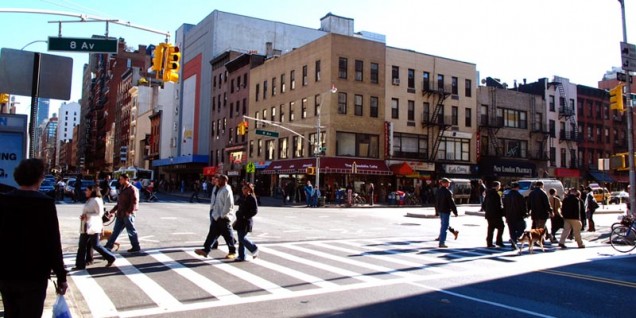One of Manhattan’s most central, beautiful, artsy and exciting neighborhoods is Chelsea. The district boundaries are roughly between 14th Street and 30th Street, to the north is the neighborhood of Hell’s Kitchen, and to the southwest is the Meatpacking District.
Chelsea’s origins date back to 1750 and the neighborhood has seen a lot of change since its days as farmland. Chelsea was the city’s first theater district, and was a fashionable shopping district. The famous Barney’s specialty store was located at 17th and Seventh Avenue for many years before moving uptown to Madison Avenue. The famous landmark Hotel Chelsea is where many famous artists, writers and musicians have stayed.
The Meatpacking District and the far west side of Chelsea—today’s New York’s premier contemporary-art district, including the recently relocated Whitney Museum of American Art —was an edgy, semi-industrial patch that hosted among the best (or worst) rowdy/sleazy bars in the City, spots like ‘The Glory Hole’ on 11th Avenue, the Kamikaze (Bruce Willis was a bartender here), and the list goes on: Everard Baths, SSS (Seventeen Street Saloon), The Eagle Bar, Crisco Disco, Rawhide Bar, The Spike, Barbary Coast, Alex in Wonderland and in more recent years the super discos Limelight and The Roxy, all of them now closed. The 1960s saw some of the City’s first underground gay clubs and the ’70s brought leather shops geared to a gay clientele. The area was later colonized by adventurous gallerists in the 1990s.
Increasingly blue chip, the district is now home to such high-profile spaces as Gagosian Gallery, Gladstone Gallery and Haunch of Venison. Chelsea’s houses sales prices have appreciated 93% over the past 5 years with many new luxury rental buildings along Sixth Avenue and many new condo developments being developed on its western portion between 10th and 11th Avenues. Chelsea has also become a hub for media and creative outlets and high energy businesses. Google recently opened their New York Headquarters here, along with numerous ad agencies and media companies as well as the new Frank Gehry designed glass building.
The development of the High Line was a major factor that contributed to a surge of visitors worldwide to the formerly desolate area. This verdant, elevated promenade offers wonderful views of the surrounding architecture—a unique mix of industrial landmarks and shining new structures—while passing through the old loading dock of the former Nabisco factory, now converted into the Chelsea Market.
The Meatpacking District runs from West 14th Street south to Gansevoort Street (and from the Hudson River to Hudson Street) owes its name to the meat distribution companies that once lined the cobblestone streets and dominated the area with rows of open-air meat markets, pork and veal packers, meatpacking plants, lumberyards and tenements. Known for its former go-go nightlife, the neighborhood offers plenty of cultural, outdoor and culinary pleasures, late-night establishments, high-end furniture stores, and fabulously expensive hairdressers.


